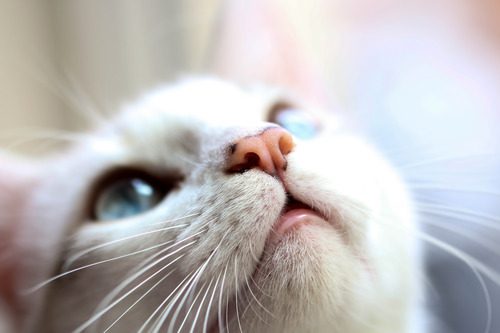Why is My Cat’s Nose Changing Color?
Why is My Cat’s Nose Changing Color?
A cat’s nose can be a fascinating indicator of their health and well-being. While some changes in nose color are completely normal, others may indicate an underlying health condition. If you’ve noticed your cat’s nose changing color, you might be wondering what it means and whether you should be concerned. This blog will explore the common reasons behind a cat’s nose color change, when it is a normal occurrence, and when it might be a reason to contact your veterinarian at North Kenny Veterinary Hospital.

Normal Causes of a Cat’s Nose Changing Color
Not every change in your cat’s nose color is a cause for concern. In many cases, these shifts are part of a natural process influenced by genetics, age, and external conditions.
Temperature and Blood Flow
One of the most common reasons for a cat’s nose changing color is temperature regulation. Just like human skin can become flushed or pale depending on circulation, a cat’s nose may lighten or darken due to changes in blood flow. If your cat has been napping in a warm spot, their nose may appear pinker. In colder conditions, reduced circulation can make it look paler or even slightly bluish.
Natural Pigmentation Changes
Certain cat breeds and individual genetics can lead to nose color changes over time. Kittens often experience pigmentation development as they grow, which can affect the shade of their noses. Some cats naturally develop freckles or dark spots on their nose as they age, particularly those with lighter-colored fur. This is known as lentigo, a harmless pigmentation change that commonly affects orange, calico, and tortoiseshell cats.
Sun Exposure
If your cat enjoys lounging in sunny spots, their nose may darken due to increased melanin production, similar to how human skin darkens with sun exposure. However, excessive sun exposure can lead to sunburn, particularly in cats with light-colored noses. In some cases, prolonged exposure may contribute to more serious skin conditions, so providing shaded areas for outdoor cats is important.
Health-Related Causes of Nose Color Changes
While many nose color changes are harmless, some may indicate underlying health conditions that require veterinary attention. If the change is sudden, accompanied by other symptoms, or persistent, it’s important to schedule a veterinary visit.
Anemia or Poor Circulation
If your cat’s nose has turned pale or white, it may be a sign of anemia, which occurs when there is a decrease in red blood cells. This condition can result from blood loss, poor nutrition, or underlying diseases. Poor circulation due to heart disease or low blood pressure can also cause the nose to appear paler than usual. If you notice your cat acting lethargic, experiencing rapid breathing, or showing a loss of appetite along with a paler nose, contact your veterinarian immediately.
Cyanosis: A Sign of Oxygen Deprivation
A bluish or purplish tint to the nose may indicate a condition called cyanosis, which occurs when the body isn’t receiving enough oxygen. This can be a sign of respiratory issues, heart disease, or lung infections. If your cat’s nose suddenly turns blue or gray, especially if they are struggling to breathe or seem weak, seek veterinary care as soon as possible.
Liver Disease and Jaundice
A yellowish tint to the nose and other areas like the ears and gums could be a sign of jaundice, which is commonly linked to liver disease. The liver plays a crucial role in filtering toxins from the body, and when it isn’t functioning properly, bilirubin levels can build up, causing yellow discoloration. Additional signs of liver disease in cats include vomiting, weight loss, and changes in behavior. If you notice any of these symptoms, a veterinary visit is recommended.
Hyperpigmentation Due to Allergies or Infections
Sometimes, a cat’s nose may develop dark spots or become darker due to skin inflammation caused by allergies or infections. Bacterial and fungal infections can lead to skin discoloration, crusting, or irritation around the nose. Allergic reactions to food, environmental factors, or even certain cleaning products can also cause changes in pigmentation. If you notice scabbing, swelling, or excessive scratching around your cat’s nose, consult your veterinarian for guidance.
Is It Time to Contact Your Veterinarian?
It’s important to monitor any changes in your cat’s nose and take note of other symptoms. While some color variations are harmless, certain signs indicate that professional evaluation is necessary. Contact your veterinarian if you notice:
- Sudden or drastic color changes in your cat’s nose
- Accompanying symptoms such as difficulty breathing, lethargy, or loss of appetite
- Crusting, swelling, or sores on or around the nose
- A bluish, purplish, or yellowish hue to the nose
- Persistent changes that do not return to normal over time
Your veterinarian can perform a thorough examination and necessary tests to determine whether the change in nose color is linked to an underlying medical issue. If you’re unsure about a recent change in your cat’s nose color, it’s always best to have it checked by a professional. Contact North Kenny Veterinary Hospital at (614) 451-1204 or request an appointment online to discuss your cat’s health and any concerns you may have.
Recent Posts
About North Kenny Veterinary Hospital
North Kenny Veterinary Hospital has been serving Columbus, OH pet families with exceptional veterinary medicine since the 1950s. We put a strong emphasis on preventive medicine as well as low-stress handling to help pets have a more pleasant veterinary experience. We use Fear Free techniques for every cat and dog to help reduce their anxiety and calm their nerves.
